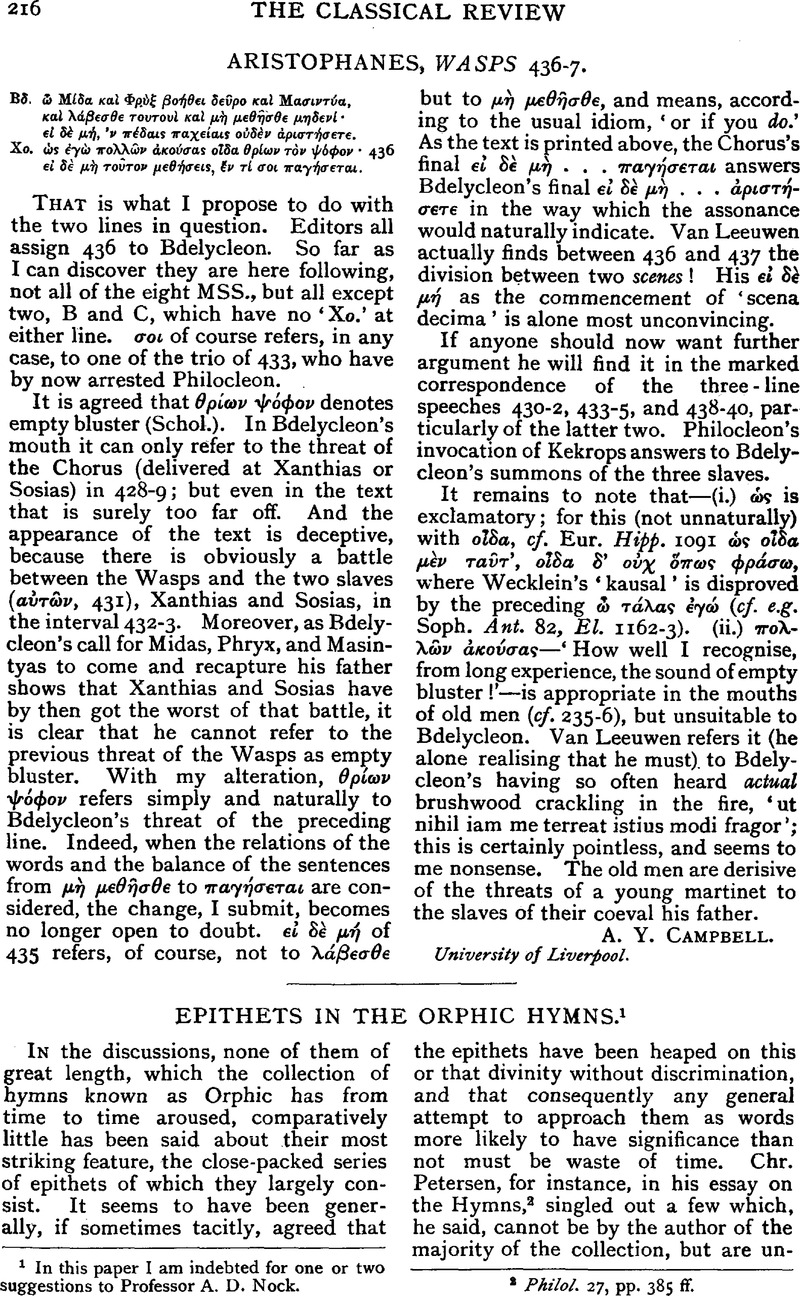No CrossRef data available.
Article contents
Epithets in the Orphic Hymns1
Published online by Cambridge University Press: 27 October 2009
Abstract

- Type
- Review Article
- Information
- Copyright
- Copyright © The Classical Association 1930
References
page 216 note 2 Philol. 27, pp. 385 ff.
page 217 note 1 Geneth. für Robert, Berlin, , 1910, pp. 94, 96Google Scholar.
page 217 note 2 Since Dieterich's argument in Hymn. Orph., Marburg, , 1891Google Scholar.
page 217 note 3 Gruppe ap. Roscher, III. 1150.
page 217 note 4 It is, of course, only from this point of view that I am claiming that they have been neglected. They have been dealt with in other respects, e.g. Hauck, M. (de Hymn. Orph. aetate, Breslau, 1911Google Scholar) has investigated with fair thoroughness their occurrences or non-occurrence in the rest of Greek literature.
page 218 note 1 E.g. Soph. Ant. 148, ἁ μεγώνυμος Nίκα Ar. Thesm. 315, Zεῦ μεγλώνυμε, etc.
page 218 note 2 An identical parallel in Batrachom. 275.
page 218 note 3 Anth. P. 6. 10.
page 218 note 4 Which Hauck (l.c, p. 29) regards as compounded from Nonn. D. 8. 67 and 48. 43. I am not claiming that these epithets are not commonplaces, and should perhaps apologise for reproducing them. It seemed well, however, to mention them all, as well as those which demand elucidation, in order to emphasise the individual character of the hymn, which is the point at issue. For a classical example of the story see Eur. Ion 987–991.
page 218 note 5 For Athena associated with horses we have ἰππία in Soph. O.C. 1070, Pind. O. 13. 115, and at Elis according to Paus. 5. 3. 3, 16. 5.
page 219 note 1 Whether this again is because the authors of the theogony were of Stoic persuasion (J.e. what are the sources of what we are here suggesting as sources) does not immediately concern us now.
page 219 note 2 Apion ap. Clem. Roman. Homil. 6. 5. 12 (Kern, Orph. Fr., 133).
page 219 note 3 Cp. Eum. 2, 3 with P. V. 211, 2.
page 219 note 4 Kern, O.F. 175, 169.
page 219 note 5 Eur. Rhes. 342.
page 219 note 6 Ap. Rhod. 3.133; Procl. Tim. 418 (= Kern, O.F. 162).
page 219 note 7 Procl. Crat. 406d (Kern, O.F. 185).
page 219 note 8 Herm. Plat. Phaedr. 248c (Kern, O.F. 105).
page 219 note 9 Ap. Rhod. 3, 133; Procl. Tim. 41 e (Kern, O.F. 162).
page 219 note 10 E.g. Corp. Herm. 5. 10a and the hymn of Synesius quoted by Kern, O.F. 206.
page 219 note 11 Damasc. de Princ. I. 123 bis (= Kern, O.F. 54).
page 220 note 1 Die Orientalischen Religionen, pp. 59 ff. (The double significance of the German ‘Berg’ helps out his meaning here.) He mentions in particular the monuments at Arslankaya and Aezani.
page 220 note 2 The identity of the deities addressed in hymns 26 and 27 should be obvious, if some immediate confirmation of this is necessary.
page 220 note 3 27. 13. It is applied to one other deity, Artemis (36. 5), where it stands next to κυνήγετι, which gives it special meaning.
page 220 note 4 See especially Calder in C.R. XXIV., pp. 77–79.
page 220 note 5 Cities of St. Paul, pp. 332, 333.
page 220 note 6 Geneth. für Robert, pp. 89 ff. It is interesting as showing the fruitfulness of this method of approach to the hymns (namely, through the study of Anatolian religion from epigraphical and numismatic, i.e. non-literary, sources), to recollect that three deities (Mίδη, *Iπτα, and Mειλινόη) quoted by Petersen (I.c., p. 413) as proof that the writer had access to lost Orphic literature because they are otherwise unknown, are all presented to us by Kern as having since turned up (the last as an epithet of Hecate) on inscriptions from Asia Minor's ‘unerschöpflichem Boden.’
page 221 note 1 Besides my own impression, I rely on Bruchmann, Epith. Deorum, Suppl. to Roscher's, Lexikon (Leipzig, 1891)Google Scholar.
page 221 note 2 Published in Jahrb. der Preuss. Kunstsamml., Vol. III, and elsewhere.
page 221 note 3 Sterrett, Pap. Amer. Sch., Vol. III. No. 532.




